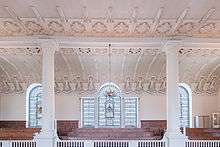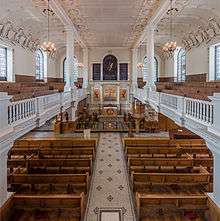St Botolph's Aldgate
| St Botolph's Aldgate | |
|---|---|
| St Botolph without Aldgate and Holy Trinity Minories | |
|
| |
 St Botolph's Aldgate | |
| 51°30′50″N 00°04′34″W / 51.51389°N 0.07611°WCoordinates: 51°30′50″N 00°04′34″W / 51.51389°N 0.07611°W | |
| Location | City of London |
| Country | England |
| Denomination | Church of England |
| Previous denomination | Roman Catholic |
| Churchmanship | Liberal / Modern Catholic |
| History | |
| Status | Active |
| Architecture | |
| Functional status | Parish church |
| Heritage designation | Grade I listed building |
| Architect(s) | George Dance the Elder |
| Architectural type | Georgian architecture |
| Years built | 1115; 16th century; 1741 |
| Completed | 1744 |
| Administration | |
| Parish | St Botolph without Aldgate |
| Deanery | City of London |
| Archdeaconry | London |
| Episcopal area | Two Cities (London and Westminster) |
| Diocese | London |
| Clergy | |
| Bishop(s) | Bishop of London |
| Rector | Laura Burgess |
| Chaplain(s) | Andrew Richardson |
St Botolph's Aldgate is a Church of England parish church in the City of London and also, as it lies outside the line of the city's former eastern walls, a part of the East End of London.
The full name of the church is St Botolph without Aldgate and Holy Trinity Minories and it is sometimes known simply as Aldgate Church.[1] The ecclesiastical parish was united with that of the Church of Holy Trinity, Minories, in 1899.
The current 18th-century church building is made of brick with stone quoins and window casings.[2] The tower is square with an obelisk spire.[3]
Position & dedication
The church stands at the junction of Houndsditch and Aldgate High Street approximately 30 metres east of the former position of Aldgate, a defensive barbican in London's wall
The church was one of four in medieval London dedicated to Saint Botolph or Botwulf, a 7th-century East Anglian saint, each of which stood by one of the gates to the City. The other three were near neighbour St Botolph-without-Bishopsgate, St Botolph's, Aldersgate in the west and St Botolph's, Billingsgate by the riverside (this church was destroyed by the Great Fire and not rebuilt).[4]
Before the legend of Saint Christopher became popular, Botolph was venerated as the patron saint of travellers, which is thought to be why churches at the City gates have this dedication.[5]
History
Medieval church
The earliest known written record of the church dates from 1115,[6] when it was received by the Holy Trinity Priory (recently founded by Matilda, wife of Henry I) but the parochial foundations may very well date from before 1066.[7]
The church was rebuilt in the 16th century[3] at the cost of the priors of the Holy Trinity,[8] and renovated in 1621.[9] It escaped the Great Fire of London, and was described at the beginning of the 18th century as "an old church, built of Brick, Rubble and Stone, rendered over, and ... of the Gothick order".[9] The building, as it stood at that time, was 78 ft long (24 m) and 53 ft wide (16 m). There was a tower, about 100 ft tall (30 m), with six bells.[9]
Eighteenth century


St Botolph's was completely rebuilt between 1741 and 1744, to a design by George Dance the Elder.[3] The exterior is of brick with projecting quoins, stone windows surrounds and a stone cornice. The tower, also of brick, has rusticated quoins, and a stone spire.[10] The interior of the building is divided into nave and aisles by four widely spaced piers[11] supporting a flat ceiling. There are galleries along three sides. The church is lit by two rows of windows in each side wall, one above and one below the gallery.[10] The monuments from the old building were preserved, and reinstalled in the new church.[11]
Nineteenth Century
The interior was redecorated by John Francis Bentley, the architect of Westminster Cathedral in the late 19th century.[12]
St Botolph's was often referred to as the "Church of Prostitutes" in the late Victorian period. The church is sited on an island surrounded by roadways and it was usual in these times to be suspicious of women standing on street corners. They were easy targets for the police, and to escape arrest the prostitutes would parade around the island, now occupied by the church and Aldgate tube station.
The parish was united with that of Holy Trinity, Minories when it closed in 1899. St Botolph's inherited from that church a preserved head, reputed to be that of Henry Grey, 1st Duke of Suffolk, who had been executed for treason by Queen Mary I in 1554.[13]
Twentieth Century
The church was severely bombed at intervals during the Blitz in the Second World War. The church was designated a Grade I listed building on 4 January 1950.[14]
Following its restoration by Rodney Tatchell, the church was much damaged by an unexplained fire in 1965, necessitating further restoration.[15]
St Botolph's was rehallowed on 8 November 1966 by the Bishop of London, in the presence of Queen Elizabeth The Queen Mother and Sir Robert Bellinger, the Lord Mayor of London, who attended in state.[3]
During an archaeological investigation of the crypt in 1990, a preserved head, reputed to be that of Henry Grey, 1st Duke of Suffolk, who had been executed for treason by Queen Mary I in 1554 was rediscovered and buried in the churchyard.[13][16]
In the early 1970s, the crypt of the church served as a homeless shelter at night and by day a youth club for Asian boys.[17]
Organ
The organ by Renatus Harris was built in the early 18th century.[11] It has undergone a historical restoration by the organ builders Goetze and Gwynn, and been returned to its 1744 specification using many of the original components. The organ has been described as the oldest church organ in the United Kingdom.[18] Although there are older pipes and cases, this is the oldest collection of pipes in their original positions on their original wind chests.[19] Because of its historic importance, the organ was filmed and recorded for the documentary The Elusive English Organ.
Donated by Thomas Whiting in 1676, it was built between 1702 and 1704. It was enhanced for the new church (the current building) by Harris' son-in-law, John Byfield, in 1740. The organ was considerably enlarged several times in the 19th century and again rebuilt by Mander Organs in the 1960s. The decision to restore the instrument was taken by St Botolph’s in 2002 after which a fundraising campaign was launched. The restoration, which took nine months, was carried out under the consultancy of Ian Bell and the workshops of Goetze and Gwynn in Welbeck, Nottinghamshire. The instrument was reinstalled in May 2006.
Notable parishioners
- Daniel Defoe was married in the church in 1683
- Thomas Bray, founder of SPCK was rector from 1706 to 1730
Other burials
References
- ↑ Hughson, D.; Higham, T.; Reid, W.H.; Sherwood, Neely, and Jones (1817). Walks Through London,: Including Westminster and the Borough of Southwark, with the Surrounding Suburbs; Describing Every Thing Worthy of Observation in the Public Buildings, Places of Entertainment, Exhibitions, Commercial and Literary Institutions, &c. Down to the Present Period: Forming a Complete Guide to the British Metropolis. 1. Sherwood, Neely, and Jones, Paternoster-row; Murray, Albermarle-Street; Clarke, New Bond-Street; Lindsell, Wigmore-Street; Chapple, Pall-Mall; Colnaghi, Cockspur-Street; Walker, Strand; Taylor and Hessey, Fleet-Street; J.M. Richardson, Cornhill; Cowie and Company Poultry; Blackwood, Princes-Street, Edinburgh; Brash and Reid, Glasgow; and M. Keene, and J. Cumming, Dublin. p. 36. Retrieved 12 June 2015.
- ↑ Cobb, G (1942). The Old Churches of London. London: Batsford.
- 1 2 3 4 Saunders, Ann (1984). The Art and Architecture of London: An Illustrated Guide. Oxford: Phaidon. p. 80.
- ↑ Daniell, A.E. (1896). London City Churches. London: Constable. p. 317.
- ↑ Richardsn, John (2001) The Annals of London: A Year-by-year Record of a Thousand Years of History, W&N, ISBN 978-1841881355 (p. 16)
- ↑ Hibbert, C.; Weinreb, D.; Keay, J. (2008). The London Encyclopaedia (revised) ed.). London: Pan Macmillan. ISBN 978-1-4050-4924-5.
- ↑ "The City of London Churches" Betjeman, J Andover, Pikin, 1967 ISBN 0-85372-112-2
- ↑ Newcourt, Richard (1708). "St Botolph, Curacy". Repetorium Ecclesiasticum Parochiale Londinense. London. pp. 250–1 of 306.
- 1 2 3 Hatton, Edward (1708). A New Picture of London. 1. London. p. 165.
- 1 2 Proposed Demolition of Nineteen City Churches. Odhams Press for London County Council. 1920. p. 20.
- 1 2 3 Pearce, Charles William (1909). Notes on Old London City Churches: their organs, organists, and musical associations. London: Vincent Music Company.
- ↑ Pevsner, Nikolaus; Bradley, Simon (1998). London:the City Churches. New Haven: Yale. ISBN 0-300-09655-0.
- 1 2 Roud, Steve (2010). London Lore: The legends and traditions of the world's most vibrant city. Arrow Books. p. 1. ISBN 978-0099519867.
- ↑ Historic England. "Details from image database (199278)". Images of England. Retrieved 23 January 2009.
- ↑ Tucker, T. (2006). The Visitors Guide to the City of London Churches. London: Friends of the City Churches. ISBN 0-9553945-0-3.
- ↑ "St Botolph, Aldgate T Q 3358 8120 (Julian Ayre, Sean O'Connor) SAB87". London Archaeologist. 6.10. 1990. Retrieved 12 January 2018.
- ↑ Colpus, Eve. “Fitting in by Being Yourself: Avenues Unlimited and Youth Work in the East End c. 1960s-2000s.” In Diasporas Reimagined: Spaces, Practices and Belonging, edited by Nando Sigona, Alan Gamlen, Giulia Liberatore, and Hélène Neveu Kringelbach, 108–11. Oxford: Oxford Diasporas Programme, 2015
- ↑ http://www.organfocus.com/features/events/stbotolphs.doc Organ restoration press release
- ↑ http://www.goetzegwynn.co.uk/restored/aldgate.shtml Restorers website
External links
| Wikimedia Commons has media related to St Botolph's Aldgate. |